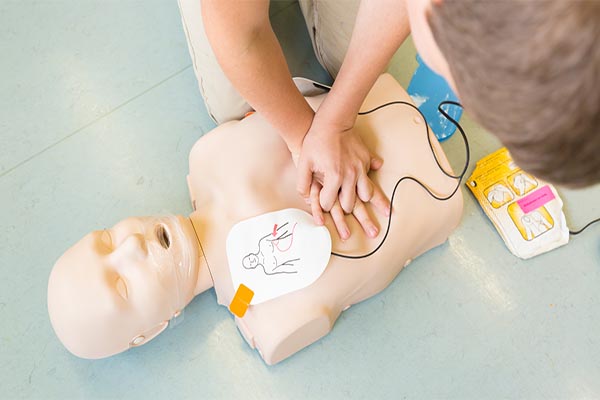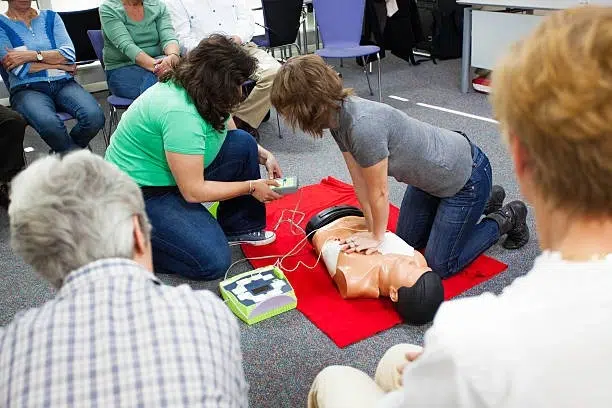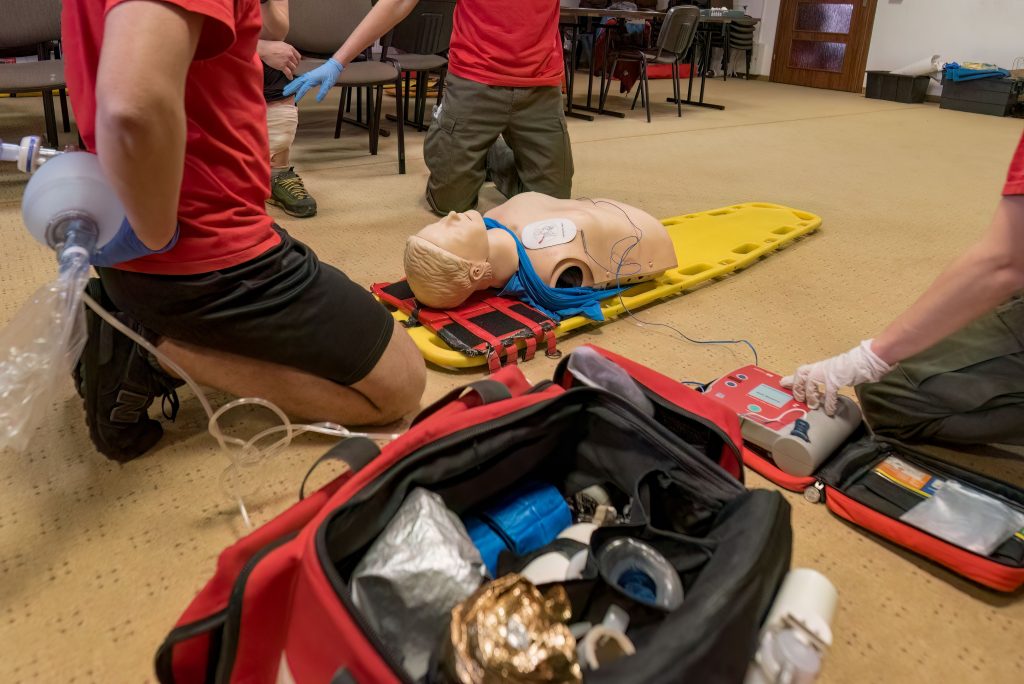
In the face of a medical emergency, every second counts. While many people are familiar with the concept of CPR, the role of another critical device, the Automated External Defibrillator (AED), is often less understood. Yet, for someone experiencing sudden cardiac arrest, the AED is the definitive treatment that can restore a normal heart rhythm. These portable, user-friendly devices are a key pillar in the emergency response to save a life. Understanding what an AED is, how it works, and its vital role is the first step toward being prepared to act when it matters most.
This comprehensive guide will demystify the AED, empowering you with the knowledge needed to recognize its importance and use it confidently. We will explore its mechanics, its relationship with CPR, and its place in the crucial Chain of Survival. You’ll learn the difference between a heart attack and sudden cardiac arrest and discover why AEDs are the only way to treat the latter. By the end, you’ll see why learning to use an AED is one of the most impactful skills you can acquire.
The Electrical Problem: Sudden Cardiac Arrest vs. Heart Attack
To truly appreciate the role of an AED, it’s essential to understand what it is designed to treat. Sudden cardiac arrest (SCA) is an electrical problem. It happens when the heart’s electrical system malfunctions, causing it to beat erratically and inefficiently, or to stop completely. This chaotic rhythm, often ventricular fibrillation (VF), prevents the heart from pumping blood to the brain, lungs, and other vital organs. A person in SCA will collapse, become unresponsive, and stop breathing normally.
This is a stark contrast to a heart attack, which is a circulation problem. A heart attack occurs when a blockage in an artery cuts off blood flow to a part of the heart muscle. While a heart attack can sometimes trigger a sudden cardiac arrest, they are not the same. A person having a heart attack is typically conscious and breathing, although they may experience chest pain or other symptoms. An AED should only be used on a person who is unconscious and not breathing normally.

How an AED Works: A Simple, Life-Saving Process
The AED’s function is straightforward, yet incredibly sophisticated. It’s a computerized device that delivers a targeted electrical shock to the heart to reset its rhythm. The entire process is designed to be used by bystanders, even those with minimal training.
- Analysis: When the AED’s pads (electrodes) are placed on the person’s bare chest, the device analyzes the heart’s electrical activity.
- Assessment: The AED’s internal computer determines if the heart’s rhythm is “shockable,” meaning it is in a state of ventricular fibrillation or pulseless ventricular tachycardia. It will not deliver a shock if it detects a normal rhythm or no electrical activity at all.
- Instruction: If a shock is advised, the device will provide clear voice prompts, instructing the user to “stand clear” and press the shock button. This safety feature ensures no one is touching the person when the shock is delivered.
- Defibrillation: A controlled electrical current is sent through the pads, traveling to the heart. This powerful shock is intended to stop the chaotic electrical activity, giving the heart a chance to restart with a normal, effective rhythm.
The AED is a “smart” device, it will only deliver a shock when necessary. This built-in safety measure means that an untrained person cannot accidentally harm someone by using it incorrectly.
The Critical Partnership: CPR and AEDs
The best chance of survival for a person in sudden cardiac arrest comes from a combination of early CPR and early defibrillation with an AED. This powerful duo works hand-in-hand to keep the victim alive until professional medical help arrives.
- CPR as a Bridge: When the heart stops, CPR keeps oxygenated blood circulating to the brain and other vital organs. It’s a temporary measure that buys valuable time. For every minute that passes without CPR and defibrillation, the chances of survival decrease by approximately 7-10%.
- AED as the Fix: While CPR keeps the body sustained, it cannot correct the underlying electrical problem. Only a defibrillation shock from an AED can do that. Therefore, the moment an AED becomes available, it should be used immediately.
- Guided Synergy: Modern AEDs are designed to guide the rescuer through the entire process. After an analysis or a shock, the AED will often prompt the user to continue chest compressions, providing a metronome or voice cues to maintain the correct rate. The device and the rescuer work together to provide the best possible care.
This synergy highlights why formal training is so important. A comprehensive CPR and AED certification course teaches you how to recognize the signs of cardiac arrest, when to call for emergency services, how to perform effective CPR, and how to operate an AED without hesitation.
Types of AEDs: Public vs. Professional
AEDs are categorized based on their intended use and level of automation. The two main types you will encounter are designed for different environments and users.
- Public Access AEDs: These are the most common type found in public places like airports, schools, gyms, and office buildings. They are specifically designed for use by laypeople with minimal or no training. They feature loud, clear voice prompts that guide the user through every step, from placing the pads to delivering a shock. They are typically fully automated or semi-automated.
- Professional Use AEDs: These devices are more advanced and are used by trained medical professionals, such as paramedics and hospital staff. They often include additional features like an ECG display, allowing the rescuer to monitor the heart’s rhythm more closely. These devices may also have a manual override function, giving trained professionals more control over the shock delivery.
Within the public access category, there are two common sub-types:
- Fully Automated AEDs: Once the pads are correctly attached to the victim, this type of AED will automatically analyze the heart rhythm and deliver a shock if one is needed, without any user intervention beyond pressing a button to turn it on.
- Semi-Automated AEDs: These devices analyze the rhythm and advise the user if a shock is necessary. However, they require the user to press a designated “shock” button to deliver the electrical current. This is the most common type found in public spaces.
The user-friendly design of public access AEDs is a testament to the idea that anyone can be a lifesaver. The goal is to make these devices so intuitive that hesitation is removed from the emergency equation.
Legal Protections: Good Samaritan Laws
A common concern for bystanders is the legal risk of providing help in an emergency. However, most countries and states have “Good Samaritan” laws in place to protect individuals who act in good faith to help a person in an emergency. These laws provide immunity from liability for civil damages for those who use an AED to assist a victim of cardiac arrest, as long as they act reasonably and without gross negligence. The protection offered by these laws, combined with the safety features of modern AEDs, should give a potential rescuer confidence to act.
These legal protections exist because the benefits of immediate action far outweigh the risks. The time-sensitive nature of sudden cardiac arrest means that doing nothing is the most dangerous option. A person who is not breathing and has no pulse is in a state of cardiac arrest, and the use of an AED is their only chance for survival.

The Chain of Survival: Putting It All Together
The American Heart Association’s Chain of Survival is a recognized framework for responding to cardiac arrest. It highlights the sequence of actions that maximize the chance of a positive outcome.
- Link 1: Early Recognition and Activation: Recognizing the signs of cardiac arrest and immediately calling 911 or the local emergency number.
- Link 2: Early CPR: Starting chest compressions and rescue breaths immediately to maintain blood flow.
- Link 3: Early Defibrillation: Using an AED as soon as it becomes available to deliver a life-saving shock.
- Link 4: Early Advanced Life Support: The arrival of emergency medical services (EMS) to provide advanced medical care and transport the person to a hospital.
- Link 5: Post-Cardiac Arrest Care: Ongoing medical treatment in a hospital setting.
The AED is a crucial link in this chain, bridging the gap between bystander CPR and the arrival of professional help. Without it, the chances of survival for someone in ventricular fibrillation are drastically low.
Conclusion: Your Call to Action
The Automated External Defibrillator is more than just a piece of medical equipment; it is a beacon of hope in a life-threatening situation. Its simplicity, combined with its profound effectiveness, makes it a powerful tool for anyone who wishes to be prepared to save a life. The knowledge that a person is protected by Good Samaritan laws and that the AED will only shock if necessary should instill confidence in any potential rescuer.
By understanding the vital role of the AED and how it works in tandem with CPR, you can become an active participant in the Chain of Survival. The best way to build this confidence and acquire these critical skills is through formal training.
Don’t wait for an emergency to learn. Contact CPR Classes Near Me today to find a course and gain the skills to become a lifesaver.
FAQs about AEDs
Q1: What does AED stand for?
A: AED stands for Automated External Defibrillator. The “automated” part refers to its ability to automatically analyze a heart rhythm and decide if a shock is needed. The “external” part means that the device delivers the shock from outside the body, through pads placed on the chest.
Q2: Can I harm someone by using an AED on them?
A: No, you cannot harm someone by using an AED on them. The AED is a “smart” device with built-in safety features. It will only deliver an electrical shock if it detects a heart rhythm that requires defibrillation (ventricular fibrillation or pulseless ventricular tachycardia). If the person has a pulse or a normal rhythm, the AED will not advise or deliver a shock.
Q3: Do I need special training to use an AED?
A: While AEDs are designed to be used by bystanders with no training, formal training is highly recommended. A CPR and AED certification course teaches you how to recognize the signs of sudden cardiac arrest, when to call for emergency services, how to prepare the person’s chest for the pads, and how to follow the AED’s voice prompts confidently. Training reduces hesitation and improves the effectiveness of the response.
Q4: Can an AED be used on a child or an infant?
A: Yes, AEDs can be safely used on children and infants. Most AEDs come equipped with special pediatric pads or a child/infant mode that reduces the energy level of the shock to an appropriate level for smaller bodies. If pediatric pads are not available and the child is over eight years old or 55 pounds, adult pads can be used, following the manufacturer’s instructions. In an emergency, using an AED with adult pads is better than not using one at all.
Q5: Will an AED save everyone who is in cardiac arrest?
A: An AED will not save every person in cardiac arrest. It is specifically designed to treat sudden cardiac arrest caused by ventricular fibrillation. If the heart has stopped completely (a condition called asystole), or if the cardiac arrest is caused by an underlying issue that is not a shockable rhythm, the AED will not deliver a shock. However, for a person in a shockable rhythm, the AED is their only chance for survival. The device significantly increases the chances of survival from SCA.
Q6: What is the difference between a heart attack and sudden cardiac arrest?
A: A heart attack is a plumbing problem; it’s when a blockage in a coronary artery stops blood flow to a part of the heart. The person is usually awake and may complain of symptoms like chest pain. Sudden cardiac arrest is an electrical problem; the heart’s electrical system malfunctions, causing it to stop beating effectively. The person becomes unresponsive and stops breathing normally. A heart attack can lead to SCA, but they are not the same.

Leave a Reply